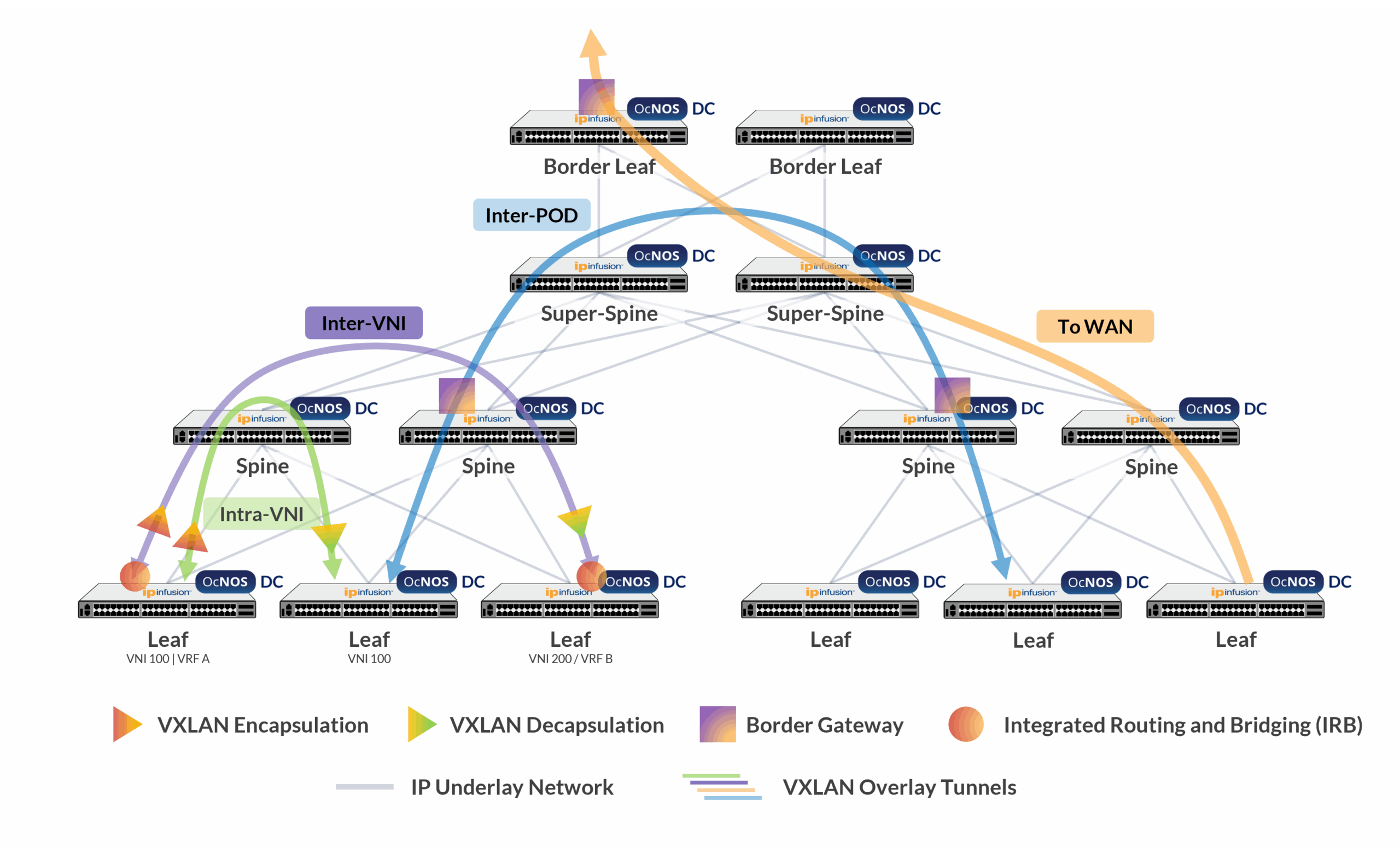
Data Center Fabric
Deploy a massively scalable, automated, and resilient data center fabric with the open, disaggregated power of OcNOS. Engineer your network for the demands of cloud, virtualization, and AI.
Discover Key Advantages in OcNOS Hybrid Cloud-Native DC Whitepaper
Modern DC Clos

Maximize Throughput and Performance
The non-blocking nature of the CLOS fabric ensures your network capacity is fully utilized, preventing traffic hotspots and allowing data to flow freely.
Predictable Low-Latency
With a fixed, two-hop path between any servers in the fabric, you get the consistent, ultra-low latency required to accelerate AI/ML and demanding workloads.
Scale Seamlessly and Cost-Effectively
The modular design lets you add capacity on demand simply by adding more switches, enabling a pay-as-you-grow model that avoids disruptive and expensive “rip-and-replace” upgrades.
What is a Non-Blocking Architecture?
A non-blocking architecture for the DC CLOS prevents internal congestion by ensuring the total uplink bandwidth from leaf switches to spine switches matches the aggregate bandwidth of all connected server ports. This 1:1 oversubscription ratio allows every server to transmit at line rate without creating bottlenecks, providing a predictable and high-performance network.
EVPN-VXLAN for DC CLOS
Your high-performance CLOS is the physical superhighway for your data, but your business services need to be deployed and scaled instantly, without being tied to specific racks or rows. EVPN-VXLAN creates secure, virtual “tunnels” over your physical network, giving you the freedom to run any service, anywhere, at any scale.
Deploy Workloads Anywhere, Instantly
Create a seamless Layer 2 network that stretches across your entire Layer 3 fabric. Place or move a virtual machine or container anywhere you have capacity.
Isolate Every Tenant and Application
Move far beyond the 4,000 VLAN limit and create up to 16 million logical networks. Build secure, completely isolated virtual networks running on the same shared physical infrastructure.
Maximize Uptime and Bandwidth
EVPN multihoming allows a server to connect to two switches in a resilient, active-active mode. Both links are always forwarding traffic – doubling available bandwidth
Understanding the DC-CLOS Fabric Topology
This diagram illustrates a modern multi-POD Data Center CLOS Fabric utilizing VXLAN EVPN, powered by OcNOS DC. It highlights the physical IP Underlay and the virtual VXLAN Overlay, showing how different traffic flows are handled to ensure scalability, efficiency, and multi-tenancy.

OcNOS DC-CLOS fabric illustrating key traffic flows
Underlay and Overlay Networks
VXLAN Encapsulation / Decapsulation
Integrated Routing & Bridging (IRB)
Traffic Flow: Intra-VNI (Layer 2)
Traffic Flow: Inter-VNI (Layer 3)
Traffic Flow: Inter-POD & To WAN
Powering Critical Workloads with OcNOS
An OcNOS-powered fabric is engineered to solve your biggest challenges. From accelerating AI to transforming your network economics, our solution provides the performance and freedom your business demands.
Accelerate Your AI Initiatives
OcNOS enables a lossless fabric tuned for the most intense workloads with support for RoCEv2 over a DCB-enabled network (PFC/ECN).
Deliver Scalable Cloud Services
With EVPN-VXLAN, you can automate service delivery and provide the stable, multi-tenant environment needed to grow your cloud business.
Lower TCO
Our disaggregated model separates network software from hardware, giving you the freedom to choose best-of-breed whitebox switches. drastically reducing TCO.
Simplify and Automate Operations
Drastically reduce operational overhead and accelerate deployments with model-driven automation: OpenConfig, NETCONF/YANG, and gNMI.
Resources & Technical Documentation
Explore our technical documentation, customer stories, and solution guides to see how the OcNOS Data Center Fabric can transform your network.
Solution Briefs & White Papers
White Paper: Migrating to Hybrid Cloud-Native Data Center
Learn the strategies and benefits of migrating to a modern, cloud-native architecture with an open networking foundation.
Solution Brief: OcNOS for AI Fabric
Discover the technical advantages of building a high-performance, lossless fabric for demanding AI/ML workloads with OcNOS.
Solution Brief: Data Center Interconnect
Learn how to build scalable, high-performance connectivity between your data center locations with OcNOS DCI.
Product & Technical Documentation
Product Page: OcNOS DC
Get an overview of our flagship Network Operating System for data center and cloud environments.
OcNOS DC Feature Matrix
Explore the comprehensive list of protocols and features supported by the OcNOS Data Center platform.
Hardware Compatibility List
Browse the extensive ecosystem of open, whitebox hardware platforms compatible with OcNOS.
OcNOS VXLAN Blogs
Data Center Solution – EVPN with VXLAN
A detailed overview of VXLAN and EVPN in the context of OcNOS, discussing its architecture and implementation.
IP Infusion Overlay ECMP
Learn about Overlay ECMP and its importance in modern data center networks.
Overlay ECMP (Part 2)
A deeper dive into the technical specifics and implementation of Overlay ECMP in OcNOS.
OcNOS CP: Introducing New Market Features
Learn about new OcNOS CP software bundles, including the EVPN-VXLAN bundle, offering upgrades from traditional L2 services.
OcNOS – EVPN VxLAN Demo
Watch a video demonstrating BGP configurations for building DC-Clos fabric and setting up EVPN-VxLAN overlay services with OcNOS.
EVPN-VxLAN Demo – Part 2
See how ARP/ND cache works in OcNOS EVPN-VXLAN Clos fabric and how MAC-Move scenarios are handled for VM mobility.
OcNOS VM Downloads
OcNOS Virtual Machine (VM)
Get familiar with OcNOS, validate configurations, and test L2, L3, and MPLS features without bare metal switches. Available from 2025.
Customer Stories & Videos
Customer Story: Scott Data
See how Scott Data, a Tier III Certified data center, deployed network disaggregation with IP Infusion OcNOS.
Customer Story: Madeo
See how Madeo achieved greater flexibility and lower TCO by transitioning to an open data center network with OcNOS.
Press Release: OcNOS AI Fabric with HYPERSCALERS
Learn how HYPERSCALERS built high-performance GPU-based services using OcNOS for their AI/ML workloads.
OcNOS Video Tutorial
Watch our technical experts walk through key configurations and use cases for the OcNOS platform.
Choose Your OcNOS DC
*Feature support is platform-dependent, refer to the Feature Matrix for details.
OcNOS® Virtual Machine
Free DownloadGet Started Today!
Speak with an IP Infusion expert to discuss your specific needs and learn how we can help you unlock the full potential of your network with open networking solutions.




